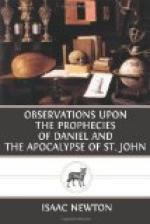I beheld, saith [4] Daniel, till the Beast was slain, and his body destroyed, and given to the burning flames. As concerning the rest of the Beasts, they had their dominion taken away: yet their lives were prolonged for a season and a time. And therefore all the four Beasts are still alive, tho the dominion of the three first be taken away. The nations of Chaldea and Assyria are still the first Beast. Those of Media and Persia are still the second Beast. Those of Macedon, Greece and Thrace, Asia minor, Syria and Egypt, are still the third. And those of Europe, on this side Greece, are still the fourth. Seeing therefore the body of the third Beast is confined to the nations on this side the river Euphrates, and the body of the fourth Beast is confined to the nations on this side Greece; we are to look for all the four heads of the third Beast, among the nations on this side of the river Euphrates; and for all the eleven horns of the fourth Beast, among the nations on this side of Greece. And therefore, at the breaking of the Greek empire into four kingdoms of the Greeks, we include no part of the Chaldeans, Medes and Persians in those kingdoms, because they belonged to the bodies of the two first Beasts. Nor do we reckon the Greek empire seated at Constantinople, among the horns of the fourth Beast, because it belonged to the body of the third.
Notes to Chap. IV.
[1] Chap. vii. 4.
[2] Chap. vii. 5.
[3] Chap. vii. 13.
[4] Chap. vii. 11, 12.
* * * * *
CHAP. V.
Of the Kingdoms represented by the feet of the Image composed of iron and clay.
Dacia was a large country bounded on the south by the Danube, on the east by the Euxine sea, on the north by the river Neister and the mountain Crapac, and on the west by the river Tibesis, or Teys, which runs southward into the Danube a little above Belgrade. It comprehended the countries now called Transylvania, Moldavia, and Wallachia, and the eastern part of the upper Hungary. Its antient inhabitants were called Getae by the Greeks, Daci by the Latins, and Goths by themselves. Alexander the great attacked them, and Trajan conquered them, and reduced their country into a Province of the Roman Empire: and thereby the propagation of the Gospel among them was much promoted. They were composed of several Gothic nations, called Ostrogoths, Visigoths, Vandals, Gepides, Lombards, Burgundians, Alans, &c. who all agreed in their manners, and spake the same language, as Procopius represents.




